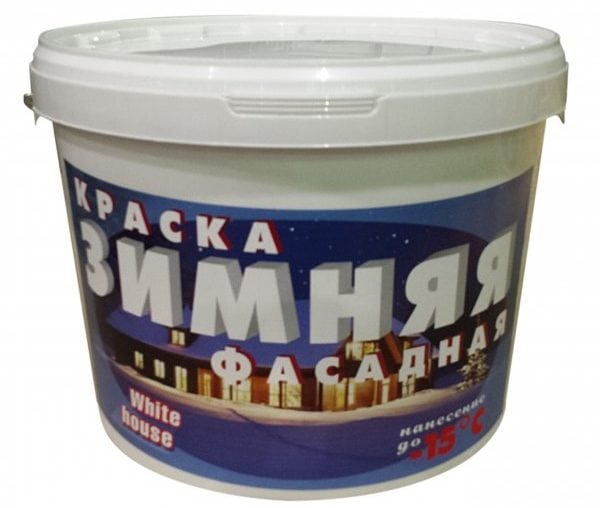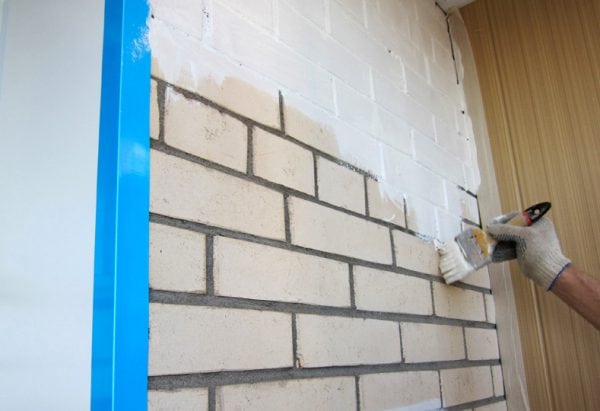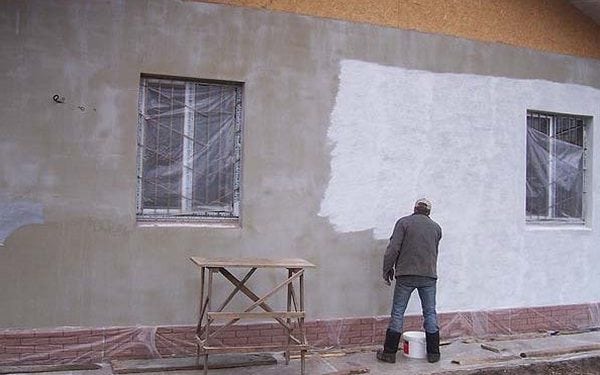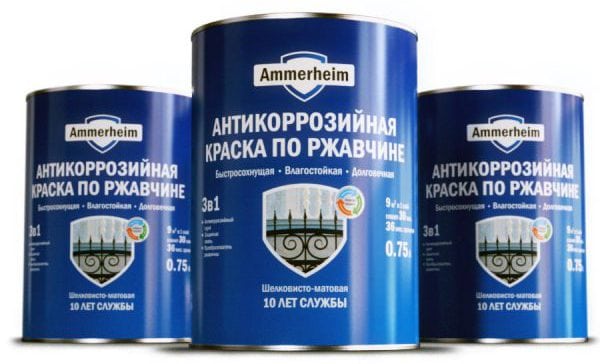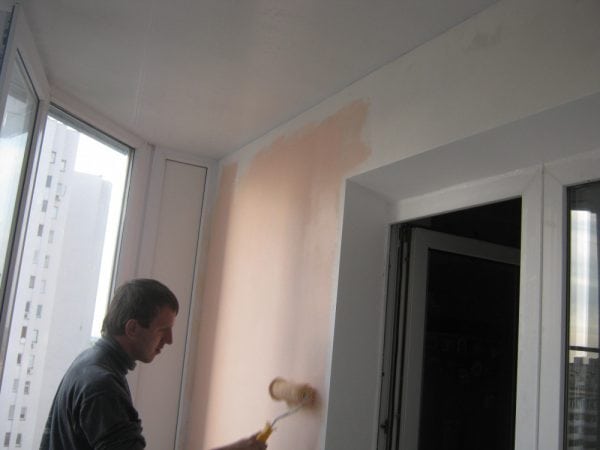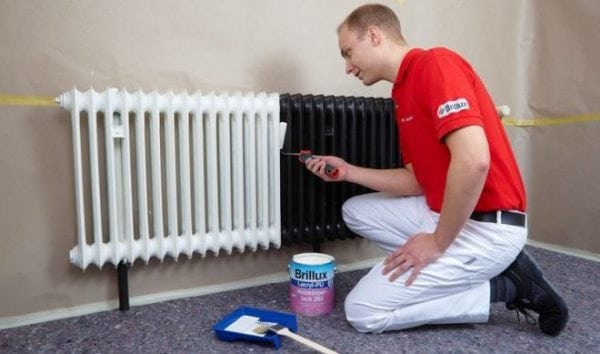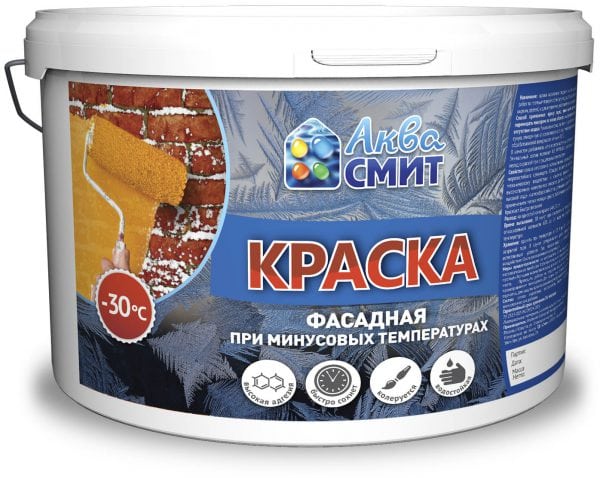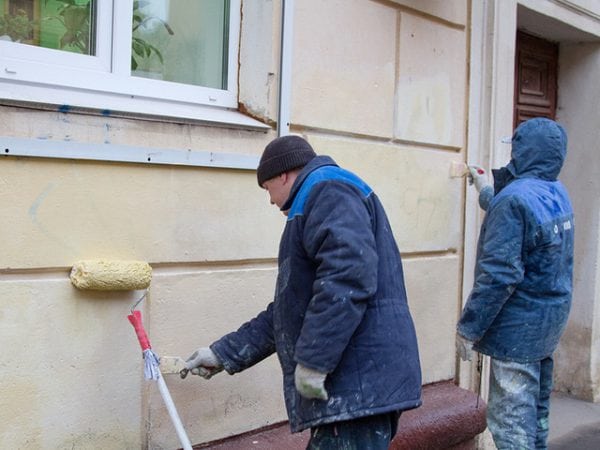Usually, paint work is planned for the warm season, when the temperature regime for this is most favorable. The lower recommended temperature threshold for painting is plus 5 degrees. But now there are a lot of modern paints and primers that are suitable even for freezing temperatures. In this regard, the minimum possible limit at which temperature can be painted on the street has changed.
- Features of painting in winter
- Recommendations for painting surfaces in cold weather
- Priming work
- Coloring the facades of the house
- Brick and surface painting with plaster
- Concrete processing
- Metal processing
- Tree painting
- Indoor painting
- Balcony
- Batteries
- Window
- What paints are used in winter
- Water based paints
- Oil paints
- Spray paints
- Storage temperature of paints and varnishes

Features of painting in winter
In industrial conditions, the need for painting at low temperatures arises if you need to deliver the object on time, or urgently need to update the surface of the building. In everyday life, such an urgency is rare, but it does happen. There are a number of features of painting in the cold season:
- The most unfavorable temperature for applying paints, enamels and primers in winter is from minus 5 degrees to plus 5 degrees. Even in cold weather it’s better to work, because it is in the specified range that condensation will form on any surface. In the presence of moisture, the adhesion of the coating is greatly deteriorated, the properties of the paints change. The quality of the coating is reduced, it will not last long.
- If you decide to paint the facades in cold weather, you need to remember - facade paint of any brand dries 2-3 times longer than in heat. To get a high-quality coating, you need to use a heat gun for drying or pull a film on a scaffold.
- You should choose only enamel, primer suitable for the winter season. Using unsuitable material will cause it to freeze, and ice will not allow the product to be applied to walls. The final result of work depends on the quality of the paint.
A number of modern paints are perfectly applied at zero temperature and in frost, some can be applied up to –20 degrees. There are good tools that are resistant to temperature extremes. It is important that the temperature of the paintwork itself is positive during operation. If the material is cold, put it in a container of warm water in a container.
to contents ↑Recommendations for painting surfaces in cold weather
In the rules for the use of primers and paints in cold air, mandatory surface preparation is mentioned. Do not use coloring materials without specific actions:
- clean the working area from the old coating;
- treat the surface with a sandblasting machine, sandpaper or other convenient method;
- close up irregularities with putty;
- if technology requires, priming (priming the walls is necessary, if indicated by the manufacturer on the packaging with paint).
You can’t work if it is raining or snowing - you need to wait until normal weather. It is necessary to carry out coloring with a roller, a brush, and it is better to forget about the airbrush - its nozzle will quickly clog.
The most important thing is to make the surface clean and dry. You should also bring the enamel to the desired viscosity. Usually, water-based paints that are diluted with water are used.It must be remembered that alkyd materials sharply increase viscosity in the cold, and do not forget to breed and heat them in time.
to contents ↑Priming work
In winter, a primer resistant to low temperatures (frost-resistant primer) is used. If iron is stained, special phosphating compounds are used. They can be applied on rust, as they include special anti-corrosion components. Primer gives additional protection against corrosion, improves adhesion of the final coating.
Coloring the facades of the house
Exterior facade work in winter is possible when choosing the right paint. After cleaning from dirt and dust, the walls are sanded, if there are patches of old paint or mold, they are removed. Then the walls are primed with the same brand of paint with the main paint - this will increase the quality of the coating. Work with packages brought from heat. As soon as the material begins to freeze, it is cleaned in heat, another packaging is carried out. A second coat of paint is usually applied after 3-5 days.
to contents ↑Brick and surface painting with plaster
The coloring of such surfaces does not differ from that of the facades of the house. It is important not to do the painting immediately after the completion of the masonry - the work is postponed, the minimum period is one year. If painted immediately, the coating will peel off. Mandatory surface preparation (cleaning with a brush from dirt, dust, mold). The broken-off plaster is cleaned, the holes are closed, and it is allowed to dry well. You can also fill deep holes with frost-resistant silicone sealant. After priming, the wall is allowed to dry for 5-7 days, then painted with a roller or brush.
to contents ↑Concrete processing
Concrete floors and walls have a porous surface. Also, the outer side of concrete products weathered faster and the dye of the coating loses its brightness. Concrete staining can be done a year after installation, it is necessary that part of the concrete dust escapes. In some cases, it is possible to paint surfaces without exposure - for example, in a workshop, in a warehouse, in a hangar.
Metal processing
In winter, it may be necessary to paint pipes, garage walls, iron sheds, sheds, profiled sheets, etc. The metal does not absorb moisture, so it does not change properties depending on the climate. For painting work, special compositions for metal should be used - at subzero temperatures they form a strong elastic film.
Tips for painting metal in winter:
- the surface must be dry, clean, free from rust with abrasive devices;
- if there is frost, the surface is treated with a flash of a gas burner - a brush or scraper will be ineffective;
- pre-degreasing isopropanol, acetone.
Tree painting
It is not recommended to paint wood, products from fiberboard, particleboard, lining in the winter. If the house is wooden outside, it is better to leave it stained until the warm season. Between the fibers of the tree, water accumulates, which freezes in the cold. The structure of the material expands, and the paint applied on top seals it in this state together with ice. After thawing, water begins to push the paint, the latter does not stand up and goes in bubbles. Also under the enamel begins rotting wood.
to contents ↑If staining is urgently necessary, pre-do the test. Stick on the surface of the tape with a wide strip, leave for 2 days, then remove. If there is condensation on the tape, they do not paint. With a dry strip, staining can be done after preliminary priming.
Indoor painting
Painting a house inside in cold weather is much easier than doing outdoor work. But the specifics of the painting must be taken into account necessarily.
Balcony
Painting a balcony or loggia in an apartment in winter may be required upon sale to improve the surface of walls, ceilings, and floors. The most difficult thing is to tint a cold balcony - it is better to wait for the plus temperature and only then carry out painting work. If absolutely necessary, you can buy a paint that can withstand low temperatures, wait for a sunny day, make sure that the walls of the loggia are warm enough, and paint.
Staining is carried out only in the morning - the coating dries faster due to warming with sunlight. A heater can be carried out to the insulated balcony with a power outlet, this will allow for quality work. Acrylic emulsion compositions are well suited for balconies - poisoning can be avoided with their use, they are environmentally friendly and odorless. Such paints increase the heat-insulating characteristics of the walls, allow them to “breathe”, very slowly fade and collapse. If there are plastic or metal parts on the balcony, it is better to cover them with varnish. Lining is covered with acrylic varnish.
to contents ↑Batteries
Painting the battery in winter has a number of features. To paint the radiator, you need to prepare a brush with metal bristles, brushes - a simple and radiator with a long handle. You will also need sandpaper, a dusting brush, a knife. Be sure to purchase a primer for metal, paint, solvent. The basic composition must necessarily be suitable for radiators and contain anti-corrosion additives, be non-toxic. Best suited remedies:
- acrylic;
- alkyd;
- water dispersion;
- silicone;
- based on heat-resistant varnish;
- zinc.
How many degrees can such enamels withstand? They are designed for a standard temperature of +80 degrees. Some are available in aerosol form - they are sold by spray can, and even the most inaccessible places can be easily painted with a spray method. It is better to remove the batteries for painting by shutting off the water supply. If this is not possible, you should wait until the batteries turn off in the spring. Hot batteries will be painted poorly, the coating often swells. After cleaning the surface, it is primed, sequential painting is done in 2 layers. Each layer should completely dry.
to contents ↑Window
Painting wooden windows in frost outside is undesirable, as well as other wood products. Only the use of heat guns will make it possible to dry the product well, but the complexity of the work will increase significantly. Inside painting is carried out similarly to how it is done in warm weather. Old paint must be removed, primed surface, then apply a suitable composition. Plastic windows can also be painted with special paints if their color needs to be updated.
to contents ↑What paints are used in winter
Enamels and primers that are used at low temperatures are diverse. Their properties:
- Do not freeze in the cold;
- suitable for different types of materials;
- can be operated at temperatures up to –10 ... –20 degrees;
- form an elastic layer;
- Dry faster than regular paint.
Water based paints
This type of paint is most in demand in the winter. The products of Dufa and Batilith, Dulux and Tikkurila, which produce many types of matching paints, are very popular. Good frost-resistant paints are produced by the German company Caparol. A number of manufacturers produce frost-resistant water-based paint AK-115, which withstands up to –20 degrees of frost. Other known materials:
- Parade f20;
- Lacra
- Alpa Façade;
- Brite Professional primer;
- Vincent Muralith F1.
Oil paints
Oil materials are now almost never used. By properties, they are much inferior to water-based paints, their service life is not higher than 2-3 years.It is necessary to dilute means with drying oil, special solvents. For work in the cold, only some paints with the marking PF, MA, GF are suitable.
Spray paints
Enamels in balloons are used, for the most part, for painting batteries, automobiles, and plastic products. They are quite expensive, but create high-quality coverage. Popular brands are:
- Maxi color;
- Colomix;
- Dupli-color;
- Vixen.
Most paints of this type can be used up to –15 degrees.
to contents ↑
Storage temperature of paints and varnishes
Usually the permissible storage temperature is indicated on the packaging of the material. According to GOST, it is possible to store paints and varnishes at a temperature of –40 ... + 40 degrees, but for each specific material individual conditions may exist.

